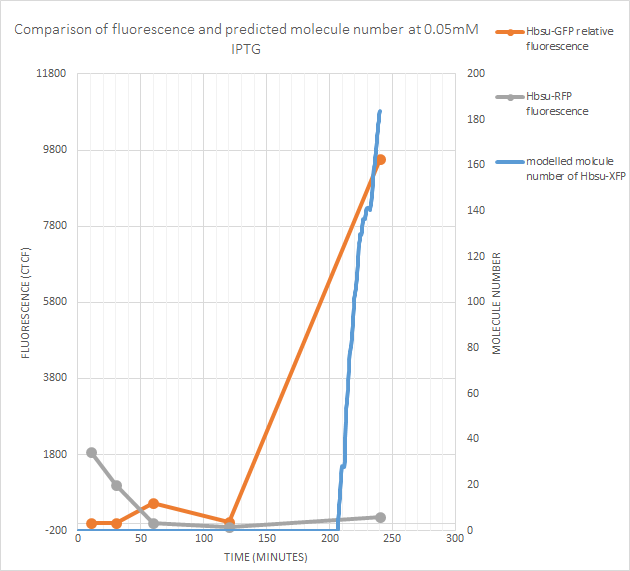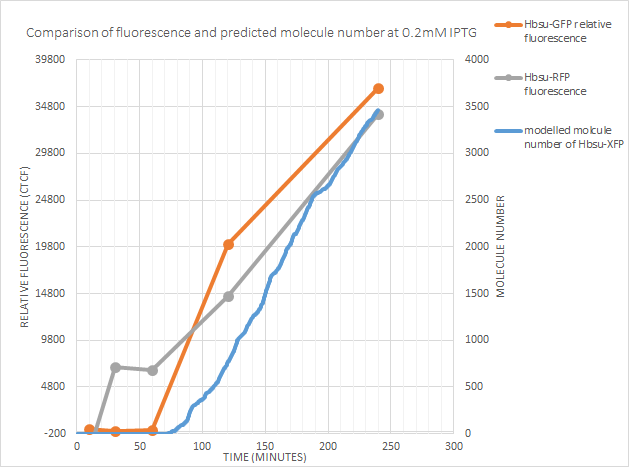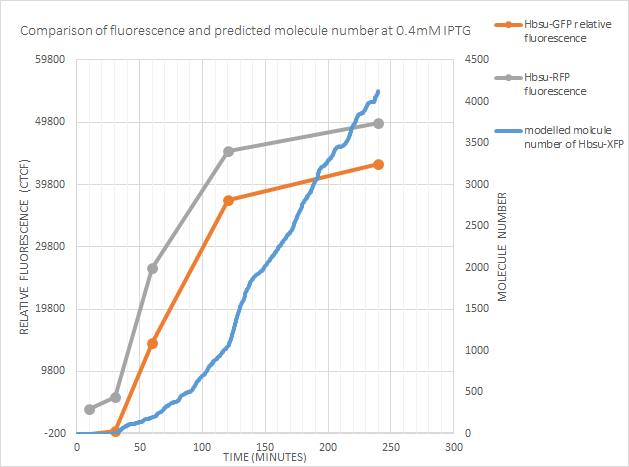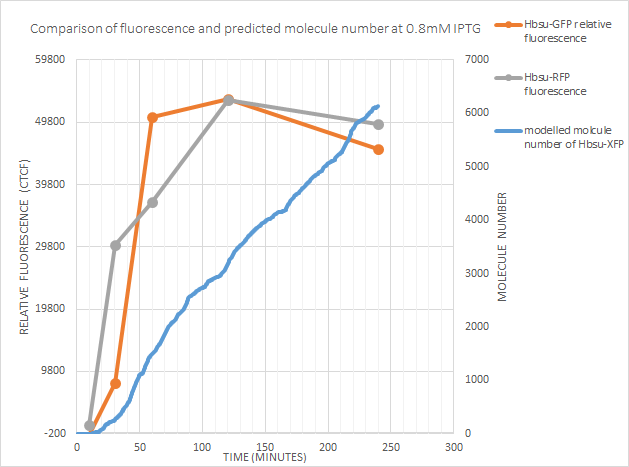Team:Newcastle/Modelling/Hbsu Fusion Protein
From 2013.igem.org
YDemyanenko (Talk | contribs) |
|||
| Line 129: | Line 129: | ||
[[File:Barecillus_fluorescence_predictedmol_number0.05mM_IPTG.png]] | [[File:Barecillus_fluorescence_predictedmol_number0.05mM_IPTG.png]] | ||
| - | ====0.1mM IPTG | + | GFP fluorescence began at some point between the recorded 100 minutes and 240 minutes. The model predicts gene expression began around 205 minutes after exposure to IPTG, which lies between these values. However RFP fluorescence is negligible. The model predicts fewer than 200 molecules of the protein produced, so this isn’t too suprising as the RFP signal is weaker than the sfGFP |
| + | |||
| + | ====0.1mM IPTG==== | ||
<!--https://static.igem.org/mediawiki/2013/c/ca/Barecillus_fluorescence_predictedmol_number0.1mM_IPTG.png--> | <!--https://static.igem.org/mediawiki/2013/c/ca/Barecillus_fluorescence_predictedmol_number0.1mM_IPTG.png--> | ||
[[File:Barecillus_fluorescence_predictedmol_number0.1mM_IPTG.png]] | [[File:Barecillus_fluorescence_predictedmol_number0.1mM_IPTG.png]] | ||
| + | |||
| + | |||
====0.2mM IPTG==== | ====0.2mM IPTG==== | ||
Revision as of 01:35, 4 October 2013

Contents |
HBsu-xFP
The BioBrick we created to visualize genome shuffling is under the control of an IPTG-inducible promoter. Normally a repressor protein is bound to it, preventing gene transcription. However IPTG can binds to the repressor, changing its shape and removing it from the promoter, allowing expression and production of HBsu-xFP. Using BioNetGen we attempted to model this system, and see if we could predict the time it took for gene expression to start, given initial concentrations of IPTG. As we had no access to Western Blotting or other techniques to determine protein production experimentally, we also attempted to link fluorescence to the average molecule numbers our model predicted.
The BioNetGen file (in .txt format, if you'd like to try it out just change the extension to .bngl)








.JPG)






























Methods
The model was simulated stochastically 25 times at 6 different initial concentrations of IPTG: 0mM, 0.05mM, 0.1mM 0.2mM, 0.4mM and 0.8mM, as these were the concentrations we used experimentally. The results for at each concentration were aggregated and averaged using R and graphed against the measured intensity of the HBsu-sfGFP/RFP fluorescence at each concentration.
This fluorescence was calculated using imageJ. As shown in Figure (), initially we used the line selection tool to drew across the cell and measure its mean fluorescence. With mean background fluorescence then measured as a control. To get a Corrected Total Cell Fluorescence (CTCF) for each cell, the mean background fluorescence was deducted from the mean fluorescence of the cell. This was done for 20 cells at each IPTG concentration. This showed that our model predicted the time taken for IPTG to bind to the repressor and allow expression of the BioBrick with reasonable accuracy. Fluorescence was measured experimentally at 0,10,30,60,120 and 240 minutes. Expression of the BioBrick began roughly when expected, although the model was less reliable at lower concentrations of IPTG, often predicting no expression within 240 minutes at 0.05mM IPTG. The stochasticity also increased at lower IPTG concentrations (until no expression was predicted), though this is to be expected
The Model
The model can be split into a few sections. The main part is the binding of 2 IPTG molecules to the protein repressing the BioBrick promoter, the repressor leaving the DNA, allowing gene expression.
IPTG(p) + DNA(prot!0,promoter~0).Rep(dna!0,a) <-> IPTG(p) + DNA(prot!0,promoter~0).Rep(dna!0,a!1).IPTG(p!1)
This represents the bonding of both IPTG molecules to the repressor
IPTG(p!1).Rep(a!1,a!2,dna!3).IPTG(p!2).DNA(prot!3,promoter~0) -> IPTG(p!1).Rep(a!1,a!2,dna).IPTG(p!2)+ DNA(prot,promoter~1)
Here the repressor leaves the operator region upstream of the BioBrick. Note that DNA(promoter~0) has changed to DNA(promoter~1) signifying that the DNA can now be transcribed.
Other repressor protein not bound to the DNA will also be attacked by IPTG, preventing them from binding to the now free DNA. This is represented by the reaction rule:
IPTG(p) + Rep(dna,a) <-> IPTG(p!1).Rep(a!1,dna)
Free repressor can still bind to the DNA however:
DNA(prot,promoter~1) + Rep(dna,a,a) -> DNA(prot!0,promoter~0).Rep(dna!0,a,a)
The next stage is the transcription and translation of the HBsu-xFP gene:
DNA(prot,promoter~1) -> DNA(prot,promoter~1) + hbsu_mRNA() hbsu_mRNA() -> hbsu_mRNA() + HBsu()
The protein will however slowly degrade:
HBsu() -> 0
Before binding to the repressor, IPTG must first diffuse into the cell:
IPTG_outside(a) -> IPTG(p)
Finally the repressor is constantly being produced and degraded. The lac repressor is a dimer-dimer. Thus the mRNA codes for a monomer, which dimerizes, and dimmerizes again:
0 -> Rep_mRNA() Rep_mRNA() -> Rep_mono() Rep_mono() + Rep_mono() <-> Rep_dimer() Rep_dimer() + Rep_dimer() <-> Rep(dna,a,a) Rep_mRNA() ->0
Parameters can be found in the .txt file, and are based on cdhbdhjbvhjvbsdjhcba The network diagram for this model is in the gallery near the top of this page, as 'contact map'.
Results
0mM IPTG
0.05mM IPTG
GFP fluorescence began at some point between the recorded 100 minutes and 240 minutes. The model predicts gene expression began around 205 minutes after exposure to IPTG, which lies between these values. However RFP fluorescence is negligible. The model predicts fewer than 200 molecules of the protein produced, so this isn’t too suprising as the RFP signal is weaker than the sfGFP
0.1mM IPTG
 "
"




